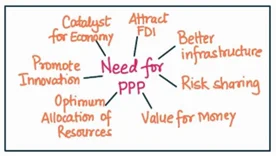Answer:
| Approach:
Introduction:
Body
- Mention about the development of airports under PPP.
- Mention the challenges in such projects.
Conclusion
- Conclude stating that a certain degree of flexibility would solve many of the problems faced by such projects.
|
Introduction:
Public-private partnerships (PPPs) are formally established agreements between public and private parties to share risks and benefits in the provision of public services and infrastructure. As per World Bank, India is one of the leading countries in terms of readiness for PPPs with ~2000 PPP projects in various stages of implementation.

Body:
India’s decision to involve private players such as GMR, GVK and Adani group has improved the passenger’s experience. It has led to better efficiency and capacity of airports. This has also resulted in massive dividend to the Airports Authority of India. Private airports are making large profits from increased traffic and other non-aero revenue opportunities.
Public Private Partnerships (PPP) is preferred in airport projects because:
- Developing and maintaining airports is a costly affair: The development, modernization and maintenance of airport infrastructure is costly while the funds with public sector for aviation is limited. PPPs can help by providing access to private sector capital and technology.
- Time-bound and cost-effective: While the public sector projects are often seen to be lagging on account of inefficiencies, private sector collaboration ensures that the projects are completed on time and in a cost-efficient manner.
- Better services: Airports would be equipped with high quality services. This would act as revenue source to private players while people get the benefit of quality service.
- Increased competition: Entry of private sector would introduce competition in a sector that would otherwise be a monopoly of AAI. This would improve the service and allow for modernization of airport infrastructure.
But PPP model in development of airport is creating following challenges for the authorities:
- There is absence of regulatory framework for the entire aviation sector.
- Less jobs: Private companies always look forward to acquiring more profit with a limited number of employees, which results in job loss.
- There is lack of clarity over the degree of risk transfer to the private players in areas such as asset condition, construction cost, operation risk, non-insurable risk etc.
- Lack of clarity in concessional agreement, revenue sharing and tariff structure framework. Tariffs are often based on the private players discretion.
- Issues in Government’s role: The projects are delayed many a times due to land acquisition issues on part of the government leading to cost overruns.
Conclusion:
The understanding between public and private players should not be rigid but flexible to overcome all problems that are currently being faced by this sector. The steps taken to address the various challenges in this field would give results soon through a booming world class aviation sector in India.
